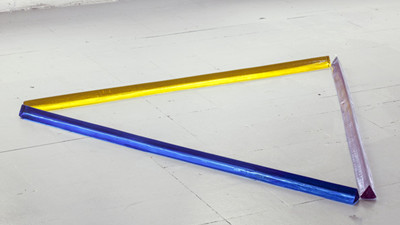威尼斯玻璃制品業
Blow up
吹制的藝術
How high art will come to the rescue of Venice's glassblowers (fingers crossed)
高雅藝術拯救威尼斯玻璃吹制匠(祈求好運)
A pointedly new approach
新穎藝術
A CITY of enchantment, Venice is also besieged with problems. It is threatened by rising sea levels, polluted lagoons and a grim economy. And glassmaking, its most famous industry, has long been sinking along with the city.
威尼斯是魅力之都,同時也是問題之城���。周邊海平面升高����,城內水質污染,經濟形勢嚴峻���。威尼斯玻璃制造業最負盛名。長期以來��,這個盛名之業也隨威尼斯一起沉落�。
Murano, an island near the city centre, has been home to glass factories for 700 years. But a shift in taste from elaborate, heavy glass to inexpensive, contemporary designs that go in the dishwasher has hurt local artisans. More than a third have shut up shop in the past decade. At the bottom end of the market Chinese glass now does the job more cheaply.
慕拉諾是城中心的一座小島,是玻璃工廠之家�,已有700年的歷史����。但是�,人們的審美情趣發生了改變�����,從原來的工藝精湛的重質玻璃轉向了能裝進洗碗機廉價設計品。這種轉變傷害了當地的工匠����,近十年里關閉了三分之一多的店鋪��。中國的玻璃產業處于行業市場的底端,其產品更加廉價��。

Venice's Chamber of Commerce estimates that 5m visitors a year trail down Murano's Fondamenta dei Vetrai , where the shop windows are stacked with glass gondoliers and grotesque glass clowns. But the profit margin for producing these gewgaws is very small. Gas prices have soared and some studios now find it more cost-effective to dispense altogether with manufacture. Some of Murano's glass studios are, however, turning to a new source of income: contemporary art. Across Venice this month no fewer than nine exhibitions feature contemporary artists using glass, only some of which are in this year's Biennale.
威尼斯商會估算����,每年會有500萬游客到慕拉諾的Fondamenta dei Vetrai觀光,街道兩旁有很多玻璃飾品商店�����,店外整齊地堆放著威尼斯船夫的玻璃像以及各種風格奇異�����、引人發笑的玻璃制品。但這些制品非常便宜,利潤微小,因為燃氣價格飆升���。一些工坊發現,省去全部的手工程序更加劃算。還有工坊轉向了新的收入來源:現代藝術�����。本月���,威尼斯有少于9家的展會�����,展出了藝術家用玻璃制成的現代藝術品��。其中一些僅是在本年的威尼斯雙年展3中展出。
Leading this local initiative is Adriano Berengo, who has divided his Murano studio in two. One side still churns out lamp stands; the other collaborates with artists such as Thomas Schütte and Tony Cragg to create works in glass in the same way that artists collaborate with a foundry. The deal is that two editions are created at Mr Berengo's expense: one is given to the artist, who can sell it, the other Mr Berengo keeps for himself. Occasionally a third edition is made and the proceeds are split between artist and studio. Mr Berengo has just completed two glass heads by Mr Schütte, which sold to a London-based Turkish collector for 200,000 ($261,000). “Cristina's Frozen Dreams” by a Catalan sculptor, Jaume Plensa, is on sale at the studio for 100,000. The glassmaker says his contemporary-art studio has an annual turnover of 6m. It beats making glass fish for 7 a throw.
此項運動是由阿德里亞諾·貝倫戈發起,他把自己的工坊一分為二�。一個繼續生產燈座���;另一個與托馬斯·舒特和托尼·克拉格合作���,創作玻璃藝術品�,跟鑄造的工作方式相同��。雙方之間有一項協議:由貝倫戈出資生產雙份藝術品�����,一份贈給作者本人,可以將其出售,另一份則由貝倫戈個人保留�。有時�����,藝術品也會制造出第三份���,所得利益就會均分?�,F在��,貝倫戈剛剛完成兩件舒特頭像。它們以20萬歐元賣給一位現居倫敦的土耳其收藏家?����,F在���,貝倫戈工坊出售加泰羅尼亞雕塑家喬瑪·帕蘭薩的作品《克里斯蒂娜冰凍的夢想》��,售價10萬歐元�����。貝倫戈說��,自己的現代藝術品工坊年營業額為600萬歐元,魚類玻璃制品每件7歐元����。
Mr Berengo founded his studio in 1989. He got the idea of working with artists by following the example of Peggy Guggenheim who reportedly said, “Glass is too important a material to be left in the hands of glass masters.” It is a sentiment he has taken to heart. But rather than wait for artists to realise they want to make glass sculptures, Mr Berengo contacts them and dangles the prospect of coming to Murano to work with a glassblower. Few refuse the challenge. So far, he has worked with more than 160 artists including Cornelia Parker, Joseph Kosuth and Cai Guo-Qiang from Britain, America and China respectively.
貝倫戈工坊創立于1989年�����。藝術家佩姬·古根海姆經說過,在一些玻璃制作大師或店主的手中,玻璃的重要性遠遠超過材料��。當時貝倫戈與他合作時得到了啟發�����,把古根海姆的這句肺腑之言銘記在心。他沒有等待�����,期待著藝術家們自發地用玻璃進行創作�����,而是與他們進行聯系�,說服他們來慕拉諾進行合作����,闡明了前景。拒絕邀請的還不多�����。迄今�����,他已經和160多位藝術大師進行了合作�,其中包括英國的科妮莉亞·帕克��,美國的約瑟夫·科瑟斯和中國的蔡國強�����。
“Artists love new toys to work with,” Mr Berengo says. “What we have to do is make them think in glass.” The results can be seen in “Glasstress: White Light/White Heat”, an exhibition that is split between the Palazzo Franchetti and a converted studio space on Murano itself. It is a mixed bag. Some artists can indeed “think in glass”. Miroslaw Balka's piece comprises a row of shutters, in wood or opaque glass, that exude a ghostly and ominous air. Francesco Gennari has gone for triangular minimalism and Gavin Turk has subverted tradition by blowing a larger-than-life glass exhaust pipe. Others, such as Tracey Emin, have not got the hang of it at all—unless her cat is an ironic comment on the kitsch glass animals found in shop windows off San Marco.
“藝術家喜歡擺弄新玩意兒,”貝倫戈說����。“我們的工作就是讓藝術家站在玻璃的角度去思考?���!睆乃囆g展“玻璃應力:白光/白熱”中可以看到成果�����。此次展覽由弗蘭凱蒂宮和威尼斯穆拉諾島貝倫哥玻璃工坊共同承攬,展品無所不包。一些藝術家確實能“站在玻璃的角度思考���。”比如,米羅斯瓦夫·巴爾卡的作品。他的作品用木材和不透明玻璃制成����,散發著一種幽靈般的神秘氣息��。弗朗西斯科·真納里的作品極簡主義三角形。還有加文·特克,他用玻璃吹制了一個具有傳奇色彩的排氣管,顛覆了傳統。其他人��,比如翠西·愛美���,她也理解了其中的真諦���,否則她關于貓的作品就是圣馬可附近商店櫥窗里那些工藝拙劣的玻璃動物的諷刺�����。
Working with artists brings other benefits than just cash. It encourages studios to discover new techniques. The Schütte head, for example, had to be blown into a lost wax mould, and required 40 days' cooling before it was completed. When Mr Berengo was asked to create a piece that resembled green bamboo, he consulted the Venetian archives and discovered that in the 16th century glassmakers had created an effect called avventurina, which makes glass look green.
與藝術家合作帶來的不僅是金錢���。工坊受到了鼓勵去發掘新技術�����。比如,制作舒特頭像,要吹進一個失蠟模具里���,需要40天的冷卻才能成型。當讓貝倫戈去創造一件類似于綠竹的作品時,他咨詢了維也那檔案館后發現�����,16世紀的玻璃工匠們已經發明了一種叫avventurina的工藝���,可以使玻璃發綠���。
Historically it is through innovation and concentrating on quality that Murano has survived the previous challenges from other glassmaking centres. David Landau, who, with his wife Marie-Rose Kahane, was one of the founders of Le Stanze del Vetro, a glass museum which has also created a centralised archive of Murano studio designs, points out that almost every century something has altered the working pattern of Murano, starting in the 16th century when the rival Dutch glass industry made a leap forward by learning how to make glass for telescopes.
縱觀歷史���,只有通過創新發明和專注質量���,慕拉諾才經受處了來自其它玻璃制造中心的挑戰�,生存至今。Le Stanze del Vetro是一家玻璃制品博物館,集中收集貝倫哥玻璃工坊藝術設計���。大衛·朗道和妻子瑪麗·加亨是博物館的創始人之一。朗道說,16世紀��,荷蘭學到了如何用玻璃制造望遠鏡后��,其玻璃產業產生了飛躍�����。此后,幾乎每個世紀都會有某樣東西改變慕拉諾的工作模式。
Mr Landau is convinced that the only way forward for Murano is to raise standards. Le Stanze del Vetro, which opened its new galleries on the island of San Giorgio Maggiore last September, has already made a mark. Its first show, by Carlo Scarpa, an architect who was also artistic director of the Venini Glassworks from 1932 to 1947, is travelling to the Metropolitan Museum of Art in New York in November. It is a reminder of Murano's pre-eminence as the backlash against cheap glass gains momentum. As Mr Landau says, it could be that Murano's future lies in its history.
朗道確信,慕拉諾在今后的進程是必須提升品質�����。去年9月���,Le Stanze del Vetro在圣喬治馬喬雷教堂小島開辦了新展館����,已經邁出了第一步����。首次展出由斯卡帕主辦。斯卡帕是位建筑師��,曾擔任威尼尼1932至1947年玻璃工藝品巡展的藝術總監�。11月,展品將前往紐約大都會藝術博物館�����。此次巡展提醒人們����,慕拉諾的突出地位強烈反對了廉價的玻璃制品的發展勢頭。正如朗道所言����,慕拉諾的未來可能根植于歷史之中���。












